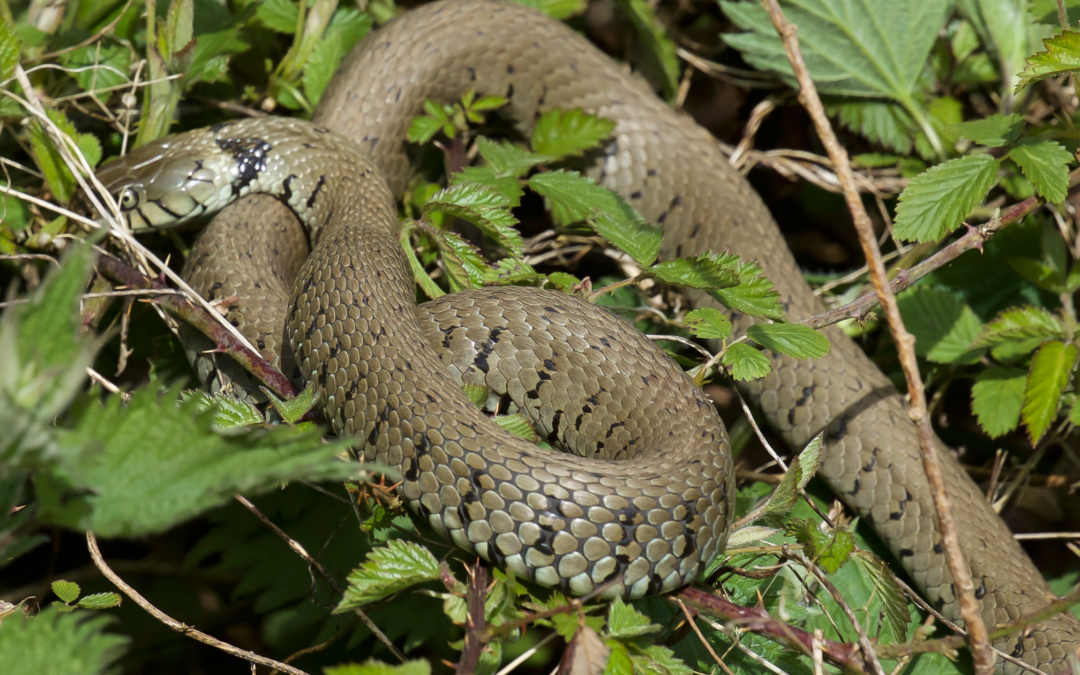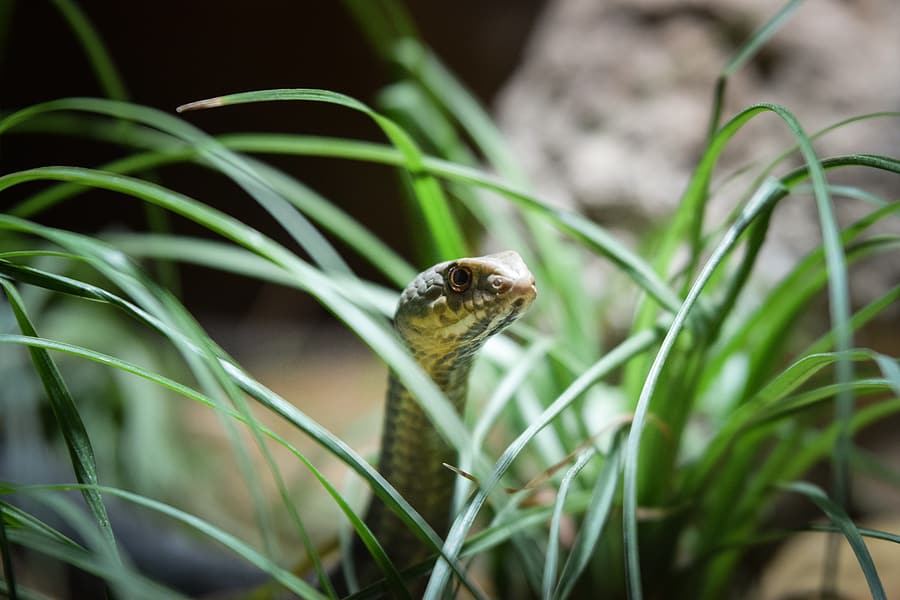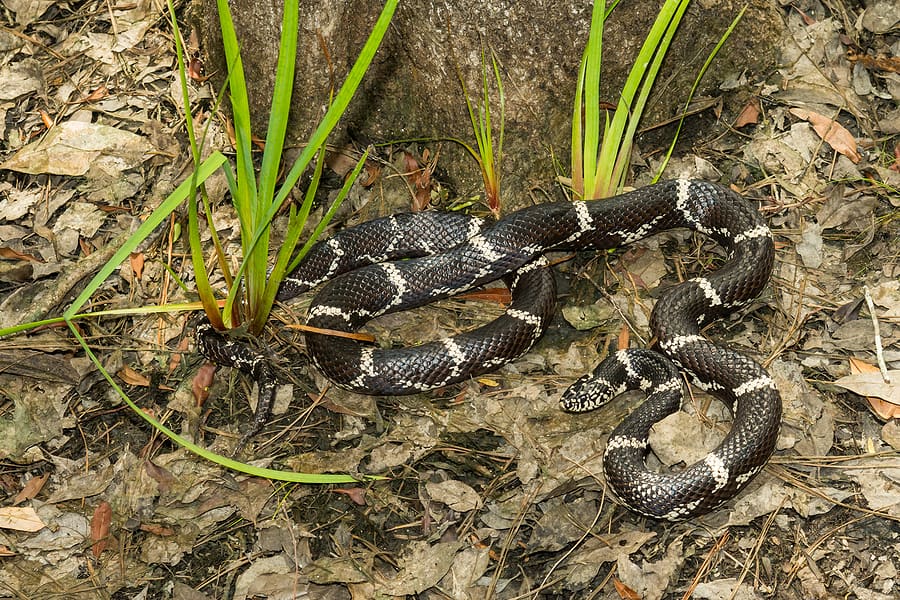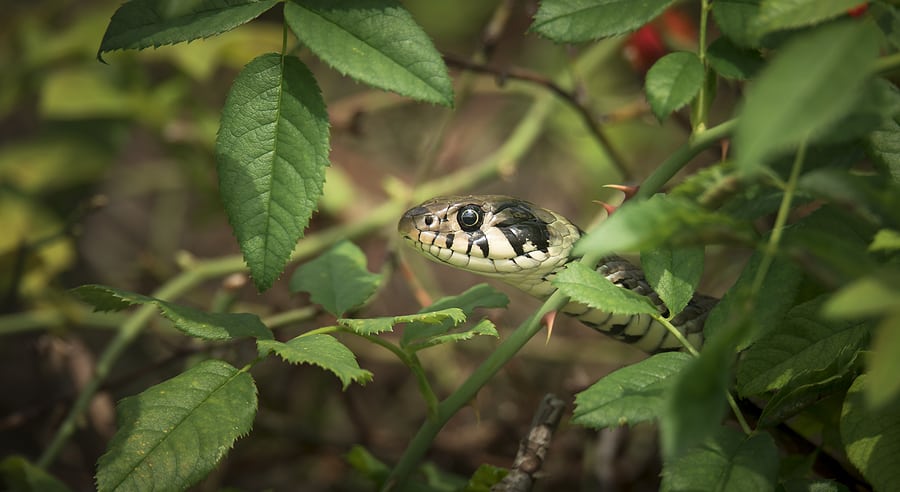
Mar 1, 2024 | Wildlife
As the weather warms up in Georgia, so does the activity of one of the area’s most misunderstood creatures: snakes. With snake season approaching, it’s essential to take proactive steps to ensure your yard is prepared for these slithery visitors. Whether you’re concerned about encountering venomous species or simply want to minimize their presence around your home, proper preparation and understanding are key. Here’s everything you need to know to get your yard ready for snake season:
When is Snake Season in North Georgia?
Snake season in Georgia typically begins in the spring, around March or April, and extends through the summer months until around September or October. During this time, snakes become more active as they emerge from hibernation and seek food, mates, and suitable habitats.
Common Snakes Found in North Georgia
Georgia is home to a variety of snake species, both venomous and non-venomous. Some of the most common snakes you may encounter include:
- Eastern Diamondback Rattlesnake
- Timber Rattlesnake
- Copperhead
- Eastern Coral Snake
- Eastern Rat Snake
- Black Racer
- Eastern Garter Snake
While most snakes in the region are harmless and play a vital role in controlling rodent populations, it’s essential to be able to identify venomous species and exercise caution when encountering any snake.
Snake Safety Tips for Outdoor Activities
Whether you’re gardening, hiking, or simply enjoying time outdoors, it’s crucial to practice snake safety to minimize the risk of encounters. Here are some tips to keep in mind:
- Wear sturdy shoes and long pants when walking in areas where snakes may be present.
- Stay on designated trails and avoid tall grass, brush piles, and rocky outcroppings where snakes may hide.
- Be cautious when reaching into dark, secluded areas such as woodpiles, rock crevices, or garden beds.
- Keep pets on a leash and supervise them while outdoors to prevent snake encounters.
- If you encounter a snake, maintain a safe distance and allow it to move away on its own. Avoid startling or antagonizing the snake.
Tips to Deter Snakes from Your Yard
While it’s impossible to completely eliminate snakes from your property, there are steps you can take to make your yard less attractive to them:
- Keep grass and vegetation trimmed short to reduce hiding places for snakes and their prey.
- Remove debris, such as logs, brush piles, and rock piles, where snakes may seek shelter.
- Seal any gaps or cracks in buildings, foundations, and fencing to prevent snakes from entering your yard.
- Install snake-proof fencing around gardens, play areas, and other high-traffic areas to keep snakes out.
- Consider natural deterrents such as certain plants (e.g., marigolds, wormwood) or commercial repellents.
If you’re concerned about snakes or other wildlife on your property, don’t hesitate to reach out to a professional pest control company near you for assistance. Our team of experts specializes in humane snake relocation, snake control, and wildlife management services tailored to your specific needs. Request a free wildlife control quote today and enjoy peace of mind knowing your yard is in good hands.
As snake season approaches, taking proactive steps to prepare your yard can help minimize encounters and ensure a safe and enjoyable outdoor experience for you and your family. By understanding common snake species, practicing snake safety, and implementing effective deterrents, you can create a snake-friendly environment that strikes a balance between coexistence and control.

Oct 20, 2023 | Pest Control
Georgia’s diverse wildlife and lush greenery make it a picturesque place to live, but it also attracts various critters, including snakes. While many snakes in Georgia are non-venomous and beneficial, encountering them in your yard can be unnerving. To ensure your family’s safety and peace of mind, we’ll explore natural ways to keep snakes away using common snake repellent plants, discuss common snakes found in Georgia, and provide tips for prevention and snake removal.
Common Snakes in Georgia
Before we dive into snake-repelling plants, let’s get familiar with some of the common snakes you might encounter in Georgia:
- Eastern Garter Snake: Harmless and small, garter snakes are commonly found throughout Georgia.
- Eastern Rat Snake: A beneficial snake that helps control rodent populations.
- Copperhead Snake: One of the few venomous snakes in Georgia, identifiable by its copper-colored head.
- Eastern Diamondback Rattlesnake: The largest venomous snake in North America, though encounters are rare.
Now, let’s explore some natural methods to keep these serpents at bay.
Repelling Snakes with Plants
- Lavender: Lavender’s fragrant scent is lovely to us but offensive to snakes. Plant it along paths and near entry points to your home.
- Marigolds: The strong odor of marigolds deters not only snakes but also a range of other pests.
- Rosemary: This aromatic herb is an excellent choice for snake repellent. Plant it around your garden or entryways.
- Onion and Garlic: Both onion and garlic plants can help keep snakes away due to their pungent scent.
- Lemongrass: Lemongrass contains citronella, which is a natural snake repellent. Plant it in your garden or keep it in pots around your outdoor areas.
Preventing and Eliminating Snakes
Aside from using snake-repellent plants, here are some additional tips to prevent and eliminate snakes from your yard:
- Keep Your Yard Neat: Trim overgrown grass, remove debris, and eliminate hiding spots like woodpiles and tall shrubs.
- Secure Your Home: Seal any cracks or gaps in your home’s foundation, windows, and doors to prevent snakes from entering.
- Control Rodents: Snakes are attracted to prey like rodents. Implement rodent control measures to reduce the rodent population in your area.
- Regular Inspections: Periodically inspect your yard for snake presence, shed skins, or nests.
- Professional Pest Control: If you’re dealing with a persistent snake problem or have concerns about venomous snakes, don’t hesitate to contact a professional pest control company. Request a free pest control quote from experts in the field.
Conclusion
Living in Georgia’s beautiful landscape also means sharing your space with wildlife, including snakes. By using snake-repelling plants, maintaining your yard, and taking steps to prevent snake encounters, you can enjoy the natural beauty of Georgia while keeping slithery intruders at bay. If you need help with pest control, request a free quote from a trusted pest control company to ensure a snake-free environment for your family.

Sep 15, 2023 | Wildlife
When it comes to living in the beautiful state of Georgia, there’s no denying that the warm climate and lush landscapes come with their fair share of wildlife encounters. One of the most common and, for many, dreaded encounters is with snakes. While Georgia is home to a variety of snake species, understanding snake control, prevention, and removal techniques is essential for safeguarding your property and your loved ones. In this blog post, we’ll explore common snakes in Georgia, when snake season typically occurs, and effective ways to keep these slithering neighbors at bay.
Common Snakes in Georgia
Before delving into snake control methods, let’s familiarize ourselves with some of the common snake species found in Georgia:
- Eastern Diamondback Rattlesnake: This venomous snake is one of the largest rattlesnake species in the world. They are mostly found in the southern part of the state.
- Copperhead: Copperheads are venomous and often have a copper-colored head. They are prevalent throughout Georgia.
- Eastern Coral Snake: Although rare, these venomous snakes can be found in certain parts of the state, particularly in the southern regions.
- Black Rat Snake: Non-venomous and beneficial for controlling rodent populations. They are widespread throughout Georgia.
- Eastern Garter Snake: Another non-venomous species often found in gardens and grassy areas.
- Eastern King Snake: These are known for their striking appearance and are valuable for keeping other snake populations in check.
When is Snake Season in Georgia?
Snake season in Georgia typically begins in the spring and lasts through the fall. During this time, snakes become more active as they search for food and suitable breeding grounds. It’s essential to be especially vigilant during these months to reduce the likelihood of unwanted snake encounters.
Ways to Keep Snakes Away from Your Home
Now that we’ve discussed common snakes and their active seasons, let’s explore effective snake control and prevention techniques to protect your home and family:
1. Maintain a Tidy Yard:
- Trim tall grass and overgrown vegetation.
- Keep firewood and debris piles away from your home.
- Regularly clean up fallen leaves and debris.
2. Seal Entry Points:
- Inspect your home for any gaps or cracks in the foundation, walls, and doors.
- Seal gaps around utility pipes and drainage lines.
- Repair damaged screens and vents.
3. Remove Attractants:
- Secure trash cans with tight-fitting lids.
- Keep bird feeders and pet food indoors or in secure containers.
- Minimize rodent populations to reduce snake prey.
4. Install Snake Fencing:
- Consider installing snake-proof fencing around your property.
- These barriers can deter snakes from entering your yard.
5. Professional Snake Control and Removal:
- If you spot a snake on your property or inside your home, do not attempt to handle it yourself.
- Contact a licensed pest control professional for safe snake removal.
Protecting Yourself from Snake Bites
While preventing snake encounters is the first line of defense, it’s also crucial to know how to protect yourself from snake bites:
- Wear sturdy boots and long pants when working in areas where snakes may be present.
- Be cautious when stepping over rocks, logs, or tall grass.
- Use a flashlight at night to watch your step in snake-prone areas.
Request a Free Wildlife Control Quote
The importance of effective snake control and removal cannot be stressed enough. While Georgia’s natural beauty and warm climate make it an attractive place to live, it’s essential to be prepared for encounters with snakes. By following these snake control and prevention tips, you can create a safer environment for your family and minimize the chances of unwelcome snake guests. Remember that professional assistance through your local pest control company is just a phone call away if you ever need help with snake removal or control. Stay vigilant, stay safe, and enjoy all that Georgia has to offer!

Aug 11, 2022 | Pest Control, Wildlife
As the season shifts from summer to early fall, cooler weather is around the corner. Many pests begin the hustle and bustle of preparing for winter – scavenging and storing food, finding a place to hibernate, or making their way into your home to overwinter. This time of year sees an increase in one pest in particular – snakes! Fall is a time for high snake activity and encounters with humans become more common.
There are many reasons snake control is important in the fall. As the leaves begin to change colors to red, orange, and brown and fall to the ground, they provide the ideal camouflage for snakes. Fall is also the time snakes begin to prepare for brumation and/or hibernation. Most snake species breed in the spring and eggs are hatched by the time autumn rolls around. These juvenile snakes are curious and more likely to be seen by humans. There are 6 venomous snake species in the southeastern United States and each of them actually breed in the fall. This means this time of year males will be actively seeking females to breed with, increasing your chance of an encounter with them. Overdevelopment in many areas has also depleted the natural habitats of many snakes, also increasing their chances of encounters with humans.
Because we see such an increase in snake activity during the fall, snake control becomes much more important. Here are some of our favorite snake prevention tips you can utilize this snake season.
- Familiarize Yourself. Identifying snakes is critical to avoiding and preventing them. Do some research and find out which snakes are common in your area, what they look like, and where to find them. Identify any areas you spend time in outdoors that could potentially house snakes and try to avoid them.
- Be Aware. Be aware of your surrounding when spending time outdoors. Look down when walking and check overhead when in wooded areas. Try to spot snakes before you walk right up on them.
- Avoid Habitats. Snakes like to hide in areas that provide them protection and coverage from predators. They can often be found in tall grass, overgrowth, on or under large rocks, rock piles, and wood piles. If you have to walk through these areas, keep your feet and legs protected, keep your eyes open
- Walk With Confidence. Snakes don’t have ears so they can’t actually hear you coming but they do respond to vibrations in the ground and can feel you coming before they actually see you. When walking outdoors walk with strong, confident steps and make your presence known.
- Cover Up. If you choose to spend time outdoors, make sure to wear closed-toe shoes and long pants if possible. Try to avoid sandals and flip flops as they leave your feet and toes exposed to potential snakebites.
- Look Up. Some types of snakes can actually climb trees and will even use overlapping branches to move from tree to tree without ever touching the ground. When walking or boating through wooded areas make sure to look up and keep an eye out for overhead snakes.
- Clean Up. Making your home and yard less inviting to snakes will help keep them from coming in. Seal any cracks and crevices on the outside of your home to keep snakes out in search of warmth and food. Remove any debris and clutter from your yard and garage. Keep woodpiles elevated and stored away from your home. Clear any overgrowth from your yard.
- Use snake repellent. There are many commercial snake repellent products on the market today. If you prefer a more green snake control option, there are also natural snake repellents you can make at home. Choose whichever option works best for you.
- Call the Pros. Snake control can be a daunting task. If you have a problem with snakes around your home, contact your local pest control company who can help identify what type of snake you are dealing with and help safely and humanely get them away from your property.
You May Also Be Interested In:
Are Mosquitoes Still Active in the Fall?
What Attracts Centipedes To Your Home?
10 Ways To Care For Your Lawn In Extreme Heat
Preparing for Fall Wildlife
Back To School Means Head Lice Season

May 12, 2022 | Pest Control
With warm weather here to stay in the South, snakes are out in full force. Spring marks the beginning of snake season as they emerge from their winter dens in search of food. While most snakes are harmless (there are only a few venomous snake species in Georgia), it can be disconcerting to come across one in your yard.
What many homeowners don’t realize is that they could be inadvertently attracting snakes to their property. Here are some of the most common things that attract snakes to your yard along with some ways to prevent them.
Food Sources
Snakes typically eat a few times per week when food sources are available. While their diet varies by species, most snakes feed on small rodents (like mice) and birds. Having an abundance of these favorite foods around your home will draw snakes to your yard.
- Inspect your yard for signs of rodents. Because they are usually not seen during the day, these pests can be present without you even realizing it. Look for holes and burrows in the ground which they use to hide from predators. Sometimes you can even find droppings in your yard. If the population is large enough, you may even see visible tracks in the grass.
- Clean up your property. Don’t leave any old food or garbage lying around rodents can use to feed on. Clean up grills regularly and keep them covered, as well.
- Keep your lawn mowed and bushes and shrubs trimmed.
- Rodents will also hide in piles of wood or in sheds/garages. Block any entrances they can use to access exterior buildings. Keep wood piles covered and elevated.
- Bring in bird feeders overnight and clean up any spilled birdseed.
- Don’t leave pet food and water out overnight.
Water Sources
Snakes need water to survive. Some species even thrive in wet environments. Common water sources include rain puddles, water features, birdbaths, pools, and ponds/lakes.
- Birdbaths not only provide a source of water but they also attract birds, another common food source for snakes. If possible, raise your birdbaths and keep them farther away from your home.
- After a rainstorm, take note of where puddles form in your yard. Use dirt or soil to fill them in or even these low lying areas out.
- Keep pools maintained with appropriate treatments and cleaning.
- Lakes and ponds house fish, frogs, and birds which are another source of food for snakes. Trim the grass and plants around any bodies of water on your property. Consider building a small fence around it that snakes cannot climb over.
Ground Cover
Snakes will seek shelter wherever they can find it. Tall grass and overgrown shrubs provide the perfect cover for snakes from predators and also allows them to camouflage themselves when sneaking up on their prey.
- Keep landscaping maintained throughout the season.
- Keep grass mowed short. The blades of your grass should be short enough that they don’t arch over. This creates a tunnel snakes can use to move through.
- Use an edger or weedwhacker to trim tall grass and weeds from fence lines, as well.
- Avoid overwatering your lawn. Not only does overwatering make the grass grow faster and need to be mowed more often, it also attracts frogs, toads, and other pests that are a good alternative food source for snakes.
- Keep shrubs and bushes trimmed so that there is no contact between the shrubs and the ground. This helps eliminate hiding spots for snakes.
Cool Environments
Snakes are coldblooded and prefer to spend most of their time when not hunting in cool, dark, humid environments. This keeps them from overheating and allows them to cool off after a hunt. Snakes can often be found hiding in wood piles, bushes, garages, and sheds.
- Try to make these common hiding places less attractive to snakes.
- Keep open spaces cleared. Clean up woodpiles, debris, rock piles, pool toys and accessories, children’s toys, etc. Snakes will look for anything that can pile up and remain undisturbed to hide out in.
- Most snake species thrive when humidity is between 40 and 50%. Consider using a dehumidifier in garages and sheds to keep humidity levels lower.
- Check your foundations and the exterior of your home/other buildings. Gaps and cracks in foundations, exterior walls, garages, and sheds provide the ideal hiding spot for snakes. Repair gaps, cracks, and holes immediately.
Most snakes aren’t harmful to humans and, in fact, can be beneficial to have around as they help keep other pest populations under control. If you have a problem with snakes, contact your local pest control company for a snake removal and prevention plan that best suits your situation.
You May Also Be Interested In:
How to Avoid Stinging Insects at Home
How Fast Do Termite Treatments Work?
What Types of Grasses Work for My Georgia Lawn?
Controlling Birds During the Summer Months
Which Pests Are Active In Your Area?




